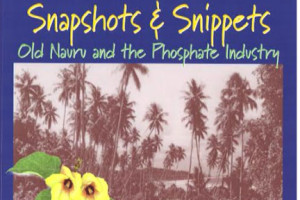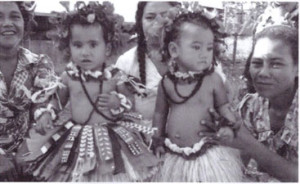Nauru – known for coconut, phosphate and not just for the detention centre
By Kersi Meher-Homji
BOOK REVIEW
Snapshots & Snippets ”“ Old Nauru and the Phosphate Industry by Dee Goodey, SOS Print & Media Group (Aust) Pty Ltd, 2014. Price: $60 (including postage in Australia). 256 glossy pages illustrated with rare photos. To purchase a copy, e-mail deegoodey@westnet.com.au
Nauru is very much in the news these days as the detention centre for asylum seekers. However, very few know the history of Nauru, its beauty and the richness of phosphate industry over there. Also how many of us know that Nauru was first known as Pleasant Island? Author Dee Goodey is to be congratulated for her original and painstaking research.
Goodey starts off with Nauru’s geographic location and historical background. Lying 0’32” south of Equator and 166 °56’ east of Greenwich, the island of Nauru is a small dot all alone in the middle of the Pacific Ocean. She writes, “In 1798 Captain John Fearn sailed from Bengal to Australia aboard the British ship Hunter. In Port Jackson (NSW) his crew of fifty men discharged a cargo of horses, cows and Indian goods, making a lucrative profit.”
From Port Jackson Captain Fearn sailed to New Zealand and on his return voyage to Bengal he discovered Nauru on November 8, 1798. He found the island so lush and green that he named it Pleasant Island. The natives called it Anaoero which means: I am going to the beach to lay my bones.
In the beginning Pleasant Island remained unknown to outsiders. But slowly sailors whispered to other sailors about this island where “a man could be his own boss and live an indolent life.”
Far from what is now in today’s political language! Even in the past it was a mix of good and bad.
In 1800s foreigners arrived for quiet life but some bad characters took the pleasantness out of Pleasant Island. Goodey narrates a horror tale of a pleasant day turning sour and violent. “One day, the tribes came together to celebrate a wedding ceremony. The bride received many bottles of coconut oil and other items as gifts. During the feast a quarrel erupted over these extra bottles. A poorly aimed pistol was fired but missed the target and a popular young chief fell dead.”
Soon the whole population became involved and the pleasant island turned into a war zone.
Subsequently, Germany became involved in Pacific trading after Britain had claimed Australia and New Zealand as her own. The Germans also travelled into Solomon Islands, Toga, Samoa and New Guinea.
For the future of Nauru, talks continued between Great Britain and Germany. It was suggested that a boundary line be drawn; island north of the line would be under Germany and south of the line be under Britain.
The book also details the prosperous side of Nauru. The name of the game was copra (kernel of coconut) and factories of Germany were ready to process copra into soap, oil and margarine. Pleasant Island had one of the richest sources of copra in the Pacific. By 1884 three trading companies were represented on the island.
In 1988 Pleasant Island was renamed Nauru. It became a republic in January 1968.
The richness of Nauru is its Phosphate Industry. Albert Ellis discovered the phosphate in Nauru in 1900. The soil in Australia, New Zealand, Britain and Japan lacked phosphates needed to support their growing primary food industry.
In its raw state, explains Goodey, phosphate will not sustain growth as it is insoluble in water. But if one crushes it fine, mixes it with sulphuric acid and we have phosphate of lime or just ”˜super’. Livestock fed on grass topped with ”˜super’ produced better meat and richer milk.
Everybody loved ”˜super’.
World War I hardly caused a ripple in the daily life of the Nauruan people and the years following the War were prosperous for everyone in Nauru.
There are interesting chapters on The Japanese occupation, Prisoners in Truk, the Boat Harbour, Anibare Bay and fascinating Tales and Truths. Maps of Nauru and South Pacific Ocean add to the value of this super publication.
Dee Goodey has first-hand knowledge of Nauru. Her dad, Lindsay Louis Martin, was employed by the British Phosphate Commission from 1929 onwards in Nauru. Her parents lived in Nauru till 1958. Now living in Sydney, Dee visited Nauru in March 1999 and was so fascinated that she visited it six months later with her husband Kevin. She needed to find out more of the history of the island that had formed her early years. Result is this fascinating book.
This is Dee’s first book. When I asked her about her feelings after seeing the book in print, she replied, “Stunned, followed rapidly by tears of joy and disbelief.”
This classy publication is illustrated with almost hundred photographs of the local population, trees, planes, food, boats, sports, Nauru stamps… These are rare photos (see below for a selection) and are worth the price of buying the book.
Short URL: https://indiandownunder.com.au/?p=4857


